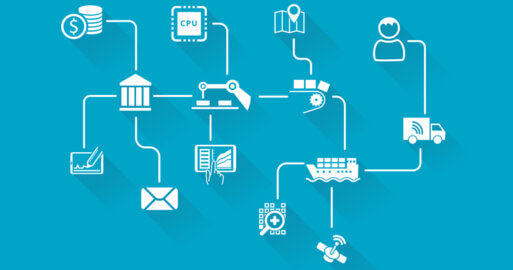Data Integration Needs to Play an Integral Role in Your Digitalisation Strategy

Digitalisation is leaving an indelible mark on the 21st century. However, advancing the digital transformation of a company, organisation or public body involves dealing with some challenges. This is where an integration platform could help you. Find out what to look out for, and how SEEBURGER can help you, in our blog article on how data integration needs to play an integral role in your digitalisation strategy.
Successful companies continually strive to optimise their internal systems, business processes and business strategies. It’s the only way they can keep maximizing their profits. And digital transformation plays a huge role in this, with digital solutions becoming increasingly important to meet market demands and align business strategy with these. One example is that well-established companies can gain and maintain a competitive advantage over new market players by tapping into the wealth of data at their fingertips.
Challenges in digital transformation
However, actually implementing a digitalisation strategy is challenging for a company, as this may involve
- automating analogue processes
- connecting various IT subsystems
- installing interfaces to third party systems.
- integrating legacy systems with new, innovative solutions
Once these challenges have been mastered, however, an organisation can collate, combine and analyse data from a wide variety of sources in real time. This not only streamlines business processes, but also enables completely new forms of collaboration between employees, customers and suppliers. And this opens up completely new ways of doing business.
Why you need an integration platform in your digital transformation
An increasing number of companies are turning to an integration platform to provide and manage the integration technology they need to digitally transform their business processes. All the standard interfaces, data formats, communication standards and protocols they need are supplied on a modular integration platform. By using a modern platform such as the SEEBURGER Business Integration Suite (BIS) to integrate their data, they can digitally map and open up entire systems and processes.
Digitalising makes it possible to capture data in real time and to connect to others worldwide. However, this assumes that you can manage the increasing flood of information this produces, especially as the majority of information in an organisation arrives or exists in unstructured form. You therefore need to employ methods and tools to not only identify the information needed, but also the information behaviour – how it is searched for and used. Then, you need to access, structure and integrate the relevant content.
Drive digital transformation in your organisation by integrating your data
Big Data, the internet of things (IoT) Software as a Service (SaaS) and other cloud activities generate a constant stream of data from a wide variety of sources. This tends to result in isolated data silos within a company. However, before you can benefit from this cumulative data, it needs to be integrated and aggregated in one place. Then you can start to use the insights it contains to make strategic decisions, to create new ways of doing business, or to optimise your business processes.
What data do you need to integrate?
Data integration lets you open up entire IT infrastructures to connect suppliers, customers, tech start-ups, autonomous machines and much more. This may involve the following scenarios:
- Enterprise Application Integration (EAI) – Real time access to applications and cloud services
You can use EAI to connect systems including the following:
- Enterprise resource planning (ERP) system
- Inventory management system
- Warehouse management system (WMS)
- Accounting software
- Production planning system
- Online shops
Networking these systems in a heterogeneous IT environment requires a flexible and efficient integration platform that can process and convert a wide variety of data formats.
- B2B/EDI – Exchanging business documents to the communication standards of your industry
Electronic data interchange (EDI) is a communication technology which enables systems to electronically send and receive documents consisting of structured data.
- API – Real time data integration for cloud services and applications
An application programming interface (API) lets two programmes or systems communicate with each other in real time. Information is exchanged in the form of structured data with a defined syntax.
- MFT – Managed File Transfer
MFT describes the secure electronic transmission of sensitive and/or unstructured data of any size between systems, people or companies.
- IoT / industry 4.0 – Integrate machines, manufacturing equipment, devices and products into your business processes
The internet of things (IoT) refers to connecting physical everyday objects with the internet. IoT means that objects and products along the value chain autonomously communicate with each other to improve their performance. IoT is one of the main drivers behind industry 4.0.
If a company wants to stay competitive long term, it needs to get to grips with EAI, EDI, API, MFT and IoT, for networking and data integration is more important today than ever before. If already using an integration platform, it doesn’t take much to start connecting core functions and making their data accessible.
Only by successively expanding your integration platform can you introduce business applications, complex business processes and company-wide resources into a distributed, heterogeneous, ‛organically grown’ IT landscape.
Conclusion
The more complex your IT set-up, the more difficult it becomes to keep pace with the global advances in digitalisation. A flexible integration platform such as the SEEBUEGER Business Integration Suite (BIS), as an on-premises, cloud or hybrid solution, is the key to successfully implementing your digitalisation strategy.
Thank you for your message
We appreciate your interest in SEEBURGER
Get in contact with us:
Please enter details about your project in the message section so we can direct your inquiry to the right consultant.
Written by: Rolf Holicki
Rolf Holicki, Director BU E-Invoicing, SAP&Web Process, is responsible for the SAP/WEB applications and digitization expert. He has more than 25 years of experience in e-invoicing, SAP, Workflow and business process automation. Rolf Holicki has been with SEEBURGER since 2005.





